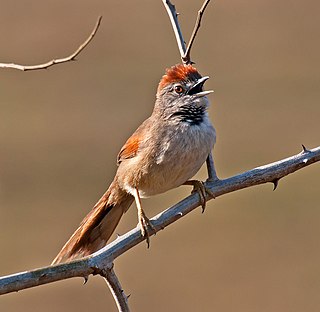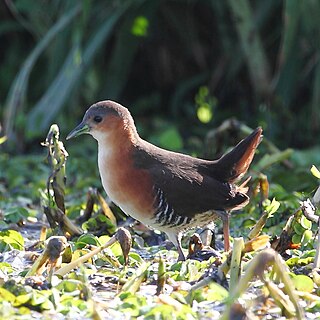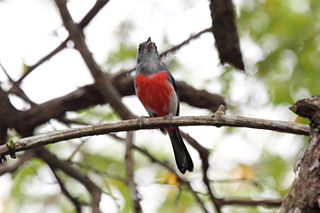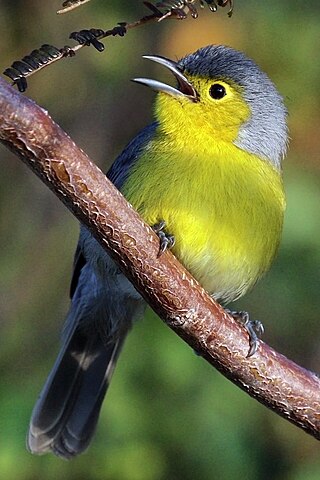
The pale-breasted spinetail is a passerine bird in the Furnariinae subfamily of the ovenbird family Furnariidae. It is found in Costa Rica, Panama, Trinidad, and in every mainland South American country except Chile and Ecuador.

The stripe-breasted spinetail is a passerine bird in the Furnariinae subfamily of the ovenbird family Furnariidae. It is found in Colombia, Trinidad, Tobago, and Venezuela.

The blue-throated starfrontlet is a species of hummingbird in the "brilliants", tribe Heliantheini in subfamily Lesbiinae. It is found in Colombia and Venezuela.

The white-throated quail-dove is a species of bird in the family Columbidae. It is found in Argentina, Bolivia, Colombia, Ecuador, and Peru.

The violaceous quail-dove is a species of bird in the family Columbidae. It is found in Argentina, Bolivia, Brazil, Colombia, Costa Rica, Guyana, Nicaragua, Panama, Paraguay, Peru, Suriname, and Venezuela.

The rufous-sided crake is a species of bird in subfamily Rallinae of family Rallidae, the rails, gallinules, and coots. It is found in every mainland South American country except Chile.

The cinnamon-throated woodcreeper is a sub-oscine passerine bird in subfamily Dendrocolaptinae of the ovenbird family Furnariidae. It is found in Bolivia, Brazil, Colombia, Ecuador, French Guiana, Guyana, Peru, Suriname, and Venezuela.

The grey-throated chat is a species of bird in the family Cardinalidae, the cardinals or cardinal grosbeaks. It is found in Belize, Guatemala, and Mexico.

The red-breasted chat is a species of bird in the family Cardinalidae, the cardinals or cardinal grosbeaks. It is endemic to Mexico.

The grey-bellied antbird is a species of passerine bird in subfamily Thamnophilinae of family Thamnophilidae, the "typical antbirds". It is found Brazil, Colombia, and Venezuela.

The long-winged antwren is a species of bird in subfamily Thamnophilinae of family Thamnophilidae, the "typical antbirds". It is found in Bolivia, Brazil, Colombia, Ecuador, French Guiana, Guyana, Peru, Suriname, and Venezuela.

The grey-throated leaftosser is a Near Threatened species of bird in the subfamily Sclerurinae, the leaftossers and miners, of the ovenbird family Furnariidae. It is found in Bolivia, Brazil, Colombia, Costa Rica, Ecuador, Panama, Peru, Trinidad and Tobago, and Venezuela.

The chestnut-throated spinetail is a species of bird in the Furnariinae subfamily of the ovenbird family Furnariidae. It is mainly found in Bolivia, Brazil, Colombia, Ecuador, and Peru.

The Oriente warbler is one of two species of bird in the Cuban warbler family Teretistridae. It is endemic to central and eastern Cuba.

The saturnine antshrike is a species of bird in subfamily Thamnophilinae of family Thamnophilidae, the "typical antbirds". It is found in Bolivia, Brazil, and Peru.

The Amazonian antshrike is a species of bird in subfamily Thamnophilinae of family Thamnophilidae, the "typical antbirds". It is found in every mainland South American country except Argentina, Chile, Paraguay, and Uruguay.

The white-bellied piculet is a Vulnerable species of bird in subfamily Picumninae of the woodpecker family Picidae. It is found in Brazil, Guyana, and Venezuela.

The black-tailed trogon is a species of bird in the family Trogonidae, the quetzals and trogons. It is found Panama and northern South America.

The gartered trogon, also known as the northern violaceous trogon, is a bird in the family Trogonidae, the quetzals and trogons. It is found in Mexico, all of Central America, and Colombia, Ecuador, Peru, and Venezuela.

The Amazonian trogon, is a species of bird in the family Trogonidae, the trogons and quetzals. It is found in Bolivia, Brazil, Colombia, Ecuador, Peru, and Venezuela.























